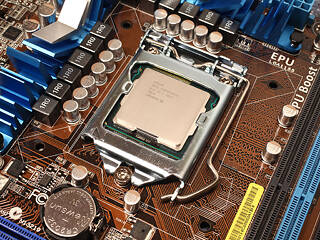 35
35
Intel Core i5-2500K Sandy Bridge GPU Performance Review
Test Setup »Introduction
First of all, I would like to thank our friends at ASUS who provided the CPU and motherboards used. Without their help it wouldn't have been possible to create this article.Intel has just announced their latest lineup of Core i5 processors. Sandy Bridge, as the new architecture is called by engineers is Intel's new microarchitecture, following Nehalem. The new processors are produced on Intel's 32 nm production process which has reached maturity over the last few months.

Unlike the last generation "Clarkdale" processor, Intel has integrated a quad-core CPU, graphics, cache, memory controller and PCI-Express connectivity into a single silicon die. Compared to a multi-chip module like on Clarkdale, this considerably reduces production cost and complexity.
Let's talk about the processor core quickly. It is a quad core design, that features Hyper-Threading technology on some models, which effectively doubles the number of threads to eight. Intel has performed several changes to the architecture to improve performance and performance per Watt, you can the full details in our Sandy Bridge CPU reviews which will be published shortly.
Intel is announcing many second generation Core Desktop processors today - they all feature integrated graphics when running on a H67 or Q67 motherboard chipset.
There are two major differences between the integrated graphics support. The first one (Clarkdale) is called "Intel HD Graphics 2000", and the other one (Sandy Bridge) is "Intel HD Graphics 3000".
Both are built on the same foundation but offer different performance levels. Intel HD Graphics 3000 offers 12 execution units (think "shaders"), whereas HD Graphics 2000 comes with only 6 of them. This means that essentially HD Graphics 3000 is twice as fast as HD Graphics 2000 when it comes to 3D applications.
Compared to the previous generation graphics cores, Intel has added substantial improvements to performance and features.
- Accelerated video encoding. This will be useful if you transcode videos, to carry them on your mobile device for example. Instead of using the CPU or GPU shaders, Intel has given their new IGP dedicated hardware for MPEG2, VC1 and AVC encode and decode. The decoder units have also been improved compared to previous generations, but the real-life difference will be negligible.
- Video Processing Accelerators. ATI and NVIDIA are offering extensive quality controls to adjust the experience of video playback to your likings with features like denoise, de-interlace, filtering and color correction. Intel has now added these features too in their graphics chip.
- 4x Anti-Aliasing. Intel now supports up to 4x AA on their graphics core which means that if you play older titles that do not require a lot of graphics processing power, you can enable Anti-Aliasing to improve the visual quality of the games.
- Support for DirectX 10.1. Yes, no DirectX 11 support. But given the limited power under the hood of Intel HD Graphics 2000 / 3000 this should not be too much of an issue.
- Support for HDMI 1.4. This means that you can now play 3D Blu-ray content - if you have a player software, the movies and the proper output device configuration. This 3D movie stuff is still very new and there will likely be several technological changes before it becomes mainstream. Nevertheless it is a nice added feature.

Intel has extended their Turbo Boost clock scheme to include the graphics processor now. So when the CPU is lightly loaded, or not all cores are loaded, the graphics engine will be automagically bumped up in clock frequency up to 1100-1300 MHz depending on the CPU model. Intel's new Sandy Bridge CPUs all come with overclocking locked down pretty tight, except for the K models where the multipliers are unlocked, for the graphics core there is no difference, all models have unlocked graphics clocks.
Unfortunately there has been no help from Intel getting support for Intel HD Graphics 2000 / 3000 added to GPU-Z, but this might change in the future.
Apr 18th, 2024 19:11 EDT
change timezone
Latest GPU Drivers
New Forum Posts
- TPU's Rosetta Milestones and Daily Pie Thread (1854)
- MSI Z790 owners - be careful, the screw can crack the chipset (2)
- Last game you purchased? (251)
- Seeking Compatible VBIOS for RX 580 8GB (20)
- Folding Pie and Milestones!! (9001)
- EDP other basically constantly red while playing games (4)
- Is it possible that the atmosphere is losing less of its "shield" capabilities due to more and more jets/rockets puncturing it daily? (19)
- Will a RTX 4070 TI super bottleneck a Ryzen 9 7950X3D? (34)
- Should the CDPR make the Fallout 5 instead? (11)
- Gigabyte gpu model differences? (59)
Popular Reviews
- Horizon Forbidden West Performance Benchmark Review - 30 GPUs Tested
- PowerColor Radeon RX 7900 GRE Hellhound Review
- Fractal Design Terra Review
- Corsair 2000D Airflow Review
- Minisforum EliteMini UM780 XTX (AMD Ryzen 7 7840HS) Review
- Creative Pebble X Plus Review
- Thermalright Phantom Spirit 120 EVO Review
- FiiO KB3 HiFi Mechanical Keyboard Review - Integrated DAC/Amp!
- ASUS GeForce RTX 4090 STRIX OC Review
- NVIDIA GeForce RTX 4090 Founders Edition Review - Impressive Performance
Controversial News Posts
- Sony PlayStation 5 Pro Specifications Confirmed, Console Arrives Before Holidays (109)
- NVIDIA Points Intel Raptor Lake CPU Users to Get Help from Intel Amid System Instability Issues (102)
- US Government Wants Nuclear Plants to Offload AI Data Center Expansion (98)
- Windows 10 Security Updates to Cost $61 After 2025, $427 by 2028 (82)
- Developers of Outpost Infinity Siege Recommend Underclocking i9-13900K and i9-14900K for Stability on Machines with RTX 4090 (82)
- TechPowerUp Hiring: Reviewers Wanted for Motherboards, Laptops, Gaming Handhelds and Prebuilt Desktops (71)
- Intel Realizes the Only Way to Save x86 is to Democratize it, Reopens x86 IP Licensing (70)
- AMD Zen 5 Execution Engine Leaked, Features True 512-bit FPU (63)


